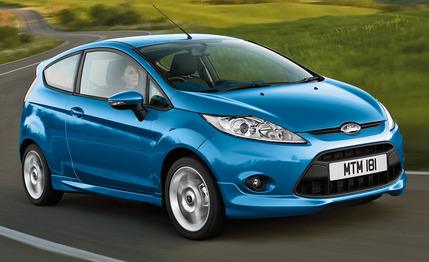
 Mini Test Road Test
Mini Test Road Test
Over the past couple of decades we’ve reviewed several impressive European Ford models that are not available to American buyers. Now, at last, here is one that will be coming to the U.S., the first product of CEO Alan Mulally’s “One Ford” global car policy: the new Fiesta.
Launched in Europe this fall, it will be built in Mexico and sold in the U.S. in 2010. Although the emphasis in the U.S. will be on the sedan version, Ford plans to offer the five-door hatchback as well, currently the most popular version of the car in Europe.
The new Fiesta was first seen as the Verve concept cars—three-door and four-door—that toured the international motor shows. The concepts have translated faithfully into production with their styling cues intact, even the novel cell-phone-inspired slanted switches on the center stack, which look good and work well.
Joe Bakaj, Ford of Europe’s engineering chief, says that the dynamics of the U.S. and European cars will be the same, a change from previous policy. If so, American drivers are in for a treat because this new Fiesta is probably the best-handling and most driver-friendly of all the world’s microcars.
At Car and Driver, we’ve praised the Honda Fit as the best of this econobox class, and the success of the Mini Cooper has shown there is enthusiasm for small cars with sporty handling. The Fiesta doesn’t have the Fit’s interior space and adaptability, but it is a better drive on a winding road. And even with the optional sport suspension, the Fiesta rides more comfortably than the Mini.
In Europe, comparisons are also being made with the Mazda 2 and for good reason: The Fiesta shares the same platform, and Mazda took the lead in its development. However, this was a shared project even before Mulally set out to unify the world, and the Ford of Europe engineering team worked alongside their Mazda colleagues in Japan. Ford fits different engines and transmissions and specifies suspension and steering settings to suit its own criteria, and, surprisingly, the Fiesta has a sportier character.
The Mazda 2 made a point of weight reduction—220 pounds less than its larger predecessor. Ford claims a savings of only 88 pounds, but that’s because the previous Fiesta is more or less the same size. The essential elements are the same as with the Mazda: greater use of high-strength steel (55 percent of the shell, in five different grades) and fractional reductions in the size and weight of components. At a claimed 2200 pounds, a Fiesta five-door is significantly lighter than any comparable car on the U.S. market.
In CO2-focused Europe, much of the talk has centered on the Fiesta ECOnetic model, which features a 1.6-liter diesel engine capable of 64 mpg on the city/highway combined cycle used in the EC. However, U.S. Fiestas will have the new Ti-VCT version of the 1.6-liter Duratec gasoline four, with variable valve timing for intake and exhaust cams.
With 118 horsepower, the 1.6 is a suitably gutsy engine for a small sporty car. Ford claims a top speed of 120 mph, good midrange torque makes it feel quick, and it achieves as high as 40 mpg on the EC combined cycle.
The Fiesta’s five-speed manual transmission is carried over from the previous model, but shift quality has been improved. The five-speed gearbox and a four-speed automatic will be offered in the U.S.
The styling is now more curved and complex and is in keeping with Ford of Europe’s current “kinetic design” ethos. The U.S. model will have more brightwork on the front to make a visual connection with Ford’s other North American cars. Otherwise, what you see here is what you’ll get.
Although it offers plenty of big-car features, one has to remember that this is a small car—just 156 inches long—and accommodations inside will be tight. The Honda does better there, but we think the Fiesta is more fun. And if you’re aiming to save fuel and money, having fun is a welcome extra.